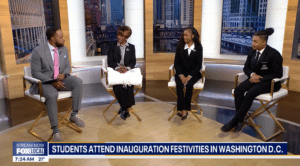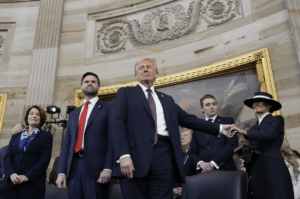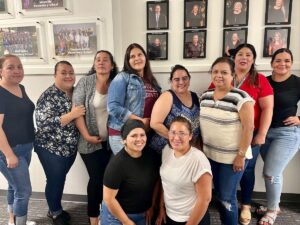 A group of students from northwest Indiana just got back from Washington D.C. They were in town during the inauguration and took part in a week-long government studies program.
A group of students from northwest Indiana just got back from Washington D.C. They were in town during the inauguration and took part in a week-long government studies program.

Donald Trump was inaugurated as the 47th president of the United States on January 20, 2025. In his first day in office, President Trump signed 26 executive orders, the most in recent history. In contrast, President Joe Biden signed nine on his first day in office and President Trump signed just one when he was inaugurated in 2017. Now, the nation is reflecting on his inaugural address and the executive orders he has already signed and is looking to President Trump’s second “first 100 days” in office.
What Did Trump Say in His Inaugural Address?
George Washington began the tradition of giving a speech upon being inaugurated, and every president since has given one. Most inaugural addresses are meant to unify the country after the campaign, reaffirm their commitment to national values such as democracy and liberty, and set forth the president’s overarching political principles. Historians and pundits say President Trump’s second inaugural address was unusual in that he laid out specific policy actions he wanted to take, from renaming Denali to Mt. McKinley to declaring the country would recognize only two genders.
While President Trump began his speech by characterizing himself as a peacemaker and a unifier, pledging to create a golden age for the country, it quickly became partisan. He mentioned the increase in his support by Hispanic and Black voters, the “radical and corrupt establishment,” and that he felt the Department of Justice had been weaponized against him. He also spoke extensively on his immigration and energy policy goals, including one of his campaign catchphrases, “Drill, baby, drill.”
Many presidents since the end of World War II have talked broadly about world peace. President Trump spoke generally about ending conflicts and having the wisdom to avoid new wars. However, he also referenced Manifest Destiny, the 19th century philosophy that the United States was divinely destined to expand its borders, which was used to justify the displacement and extermination of millions of Native Americans. He complained about Panama’s administration of the Panama Canal and declared the Gulf of Mexico will now be known as the Gulf of America.
Why Do We Keep Track of the President’s First 100 Days?
Since Franklin Delano Roosevelt’s first presidency in 1933, the country has kept track of a president’s first 100 days in office. In his first 100 days, President Roosevelt passed regulations and pushed legislation through Congress to help the country recover from the Great Depression. Ever since, presidents have been evaluated on the success of their first 100 days. The actions of a president at the start of their term can let the country know what to expect.
What Can We Expect from Trump’s First 100 Days?
Before taking office, President-elect Trump messaged that his goal for his first 100 days was to reverse President Biden’s policies and pick up where he left off in 2020. We can expect major changes to our diversity, environmental, immigration, and foreign policies.
President Trump signed an executive order declaring that there are only two genders, and that the United States would not recognize transgender people. He also ended diversity, equity, and inclusion hiring goals for the federal government. President Trump has already withdrawn the United States from the Paris climate agreement and declared an energy emergency to promote drilling on federal lands. He signed an expected, but controversial, executive order to pardon the nearly 1,500 January 6 rioters, including hundreds convicted of assaulting police, carrying firearms, and destroying property.
We can also expect lawsuits challenging many of these executive orders. The American Civil Liberties Union has already pledged to challenge President Trump’s executive order to end birthright citizenship for people whose parents are not in the country legally. The state attorney general of California is expected to file suits against President Trump’s pledge for mass deportations of undocumented immigrants.
Discussion Questions
Additional Links
Related Posts
As always, we encourage you to join the discussion with your comments or questions below.
Close Up is proud to be the nation’s leading nonprofit civic education organization, working with schools and districts across the country since 1971. If you would like to partner with us or learn more about our experiential learning programs, professional development, or curriculum design and consulting, contact us today!
Sources
 HOOD RIVER — Twenty-five Hood River Valley High School (HRV) students in the migrant education program will head to Washington, D.C., over spring break to take part in the Close Up Foundation’s High School Program, “a six day and five night program for high school students to experience their government in action”.
HOOD RIVER — Twenty-five Hood River Valley High School (HRV) students in the migrant education program will head to Washington, D.C., over spring break to take part in the Close Up Foundation’s High School Program, “a six day and five night program for high school students to experience their government in action”.